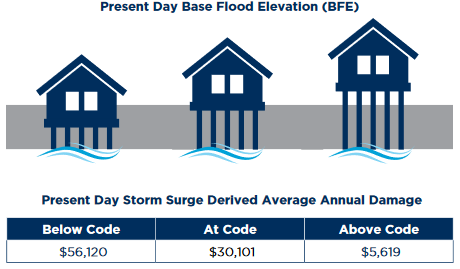Increasing climate risks, such as hurricanes and floods associated with rising sea levels, would seem to naturally drive down interest in coastal living, but new analysis from Moody’s RMS indicates that’s not the case.
The growing coastal populations, both internationally and in the U.S., means adaptation and mitigation will be necessary to “lower the built environment’s susceptibility to hazard-based damages.”
Some hazards associated with hurricanes include damaging high winds, storm surge and associated flooding, as well as extreme precipitation.
The new case study by Moody’s, “Adaption to Hurricane Risk – a Florida Case Study,” examines climate-related perils facing South Florida and how stricter building codes can reduce home damage costs by up to nearly 10 times.
Protecting against these hazards, local government can invest in coastal defense infrastructure, such as seawalls, levees and storm surge barriers.
“While construction and maintenance costs may be substantial, in the long run, the economic losses that can be avoided from property damage and business interruption make these adaptation measures economically viable,” the Moody’s report stated.
Ensuring properties remain resilient to climate risks is essential to maintaining viable insurance markets in at-risk regions, the report added.
Risk models are invaluable when it comes to measuring the financial impact of structural adaption and mitigation. Taking weather risks into account, along with frequency and severity, risk models offer a deep dive into location vulnerability and the associated hazards when exposed to a substantial weather event.
According to Moody’s case study of extreme wind and storm surge on Southern Florida properties, building codes significantly influence “predicted hurricane damage and how these damages are expected to change over time in a warming climate.”
For example, stricter building codes since the 1990s indicate a single wind event loss to a residential structure has gone from nearly $28,500 to close to $4700, demonstrating a significant loss cost reduction.
Building codes emphasizing advanced construction techniques and materials to enhance wind resistance have lowered the expected annual average damage (AAD) costs associated with intense winds by more than 6 times for standard family residences.
This is the result of Florida building codes placing greater emphasis on the use of impact-resistant windows, reinforced doors, enhanced roof coverings and stronger connections between structural elements, such as hurricane straps or clips, Moody’s said.
Future projections to 2050 indicate wind events derived from hurricanes will be even more severe, highlighting the impact better building codes have on resiliency.
With respect to storm surge, new builds in flood zones must be constructed above the base flood elevation to maintain insurance, making ground floor height an emerging predictor of storm surge risk, the Moody’s report noted.

Buildings not meeting the current code have AAD costs just under double those at code; buildings that surpass current codes have AAD costs that are nearly 10 times less than those below code.
The reductions in calculated AAD from storm surge and wind resistance risks are similar when looking out to 2050, according to the report, indicating the cost to implement adaptation measures potentially wind up paying dividends over the course of a 30-year mortgage.
Featured Image: Hurricane Ian. Credit: NOAA





















 Legal Finance and Insurance: From Confusion to Collaboration
Legal Finance and Insurance: From Confusion to Collaboration  Rebuilding Negotiation Talent: Why This Skill Is Missing and How to Fix It
Rebuilding Negotiation Talent: Why This Skill Is Missing and How to Fix It  Women Are Now Leaning Out in the Workplace
Women Are Now Leaning Out in the Workplace  Examining 5 Key Factors Fueling MGA Growth—and Emerging Challenges Ahead
Examining 5 Key Factors Fueling MGA Growth—and Emerging Challenges Ahead 




